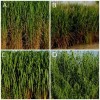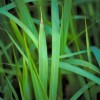 Nonnative invasive plant species pose a significant threat to Florida’s natural areas. The UF/IFAS Assessment of Nonnative Plants in Florida’s Natural Areas (hereafter, UF/IFAS Assessment) uses literature-based risk assessment tools to predict the invasion risk of both nonnative species that occur in the state as well as species proposed for introduction. The UF/IFAS Assessment team has evaluated more than 770 species, including 97 species proposed for introduction or new uses. The team is actively identifying and evaluating potentially problematic nonnative species (and sub-specific or hybrid taxa). Recommendations and supporting information from the UF/IFAS Assessment can be found at http://plants.ifas.ufl.edu/assessment. This 6-page fact sheet was written by Deah Lieurance, S. Luke Flory, Aimee L. Cooper, Doria R. Gordon, Alison M. Fox, Joan Dusky, and Linda Tyson, and published by the UF Department of Agronomy, November 2013.
Nonnative invasive plant species pose a significant threat to Florida’s natural areas. The UF/IFAS Assessment of Nonnative Plants in Florida’s Natural Areas (hereafter, UF/IFAS Assessment) uses literature-based risk assessment tools to predict the invasion risk of both nonnative species that occur in the state as well as species proposed for introduction. The UF/IFAS Assessment team has evaluated more than 770 species, including 97 species proposed for introduction or new uses. The team is actively identifying and evaluating potentially problematic nonnative species (and sub-specific or hybrid taxa). Recommendations and supporting information from the UF/IFAS Assessment can be found at http://plants.ifas.ufl.edu/assessment. This 6-page fact sheet was written by Deah Lieurance, S. Luke Flory, Aimee L. Cooper, Doria R. Gordon, Alison M. Fox, Joan Dusky, and Linda Tyson, and published by the UF Department of Agronomy, November 2013.
http://edis.ifas.ufl.edu/ag376
Tag: S. L. Flory
Cogongrass (Imperata cylindrica) Biology, Ecology, and Management in Florida Grazing Lands (SSAGR52/WG202)
 Cogongrass is found on every continent and is considered a weedy pest in 73 countries. In the U.S., cogongrass is found primarily in the Southeast. It was accidentally introduced into Alabama in the early 1900s, and purposely introduced as a potential forage and soil stabilizer in Florida (and other states) in the 1930s and early 1940s. However, soon after investigations began it was realized that cogongrass could be a weedy pest. Since its introduction, cogongrass has spread to nearly every county in Florida. In some cases, it has completely taken over pastures so that it is the only species present. This is a common thread where cogongrass invades; it quickly displaces desirable species and requires intensive management. This 5-page fact sheet was written by B. A. Sellers, J. A. Ferrell, G. E. MacDonald, K. A. Langeland, and S. L. Flory, and published by the UF Department of Agronomy, August 2012.
Cogongrass is found on every continent and is considered a weedy pest in 73 countries. In the U.S., cogongrass is found primarily in the Southeast. It was accidentally introduced into Alabama in the early 1900s, and purposely introduced as a potential forage and soil stabilizer in Florida (and other states) in the 1930s and early 1940s. However, soon after investigations began it was realized that cogongrass could be a weedy pest. Since its introduction, cogongrass has spread to nearly every county in Florida. In some cases, it has completely taken over pastures so that it is the only species present. This is a common thread where cogongrass invades; it quickly displaces desirable species and requires intensive management. This 5-page fact sheet was written by B. A. Sellers, J. A. Ferrell, G. E. MacDonald, K. A. Langeland, and S. L. Flory, and published by the UF Department of Agronomy, August 2012.
http://edis.ifas.ufl.edu/wg202